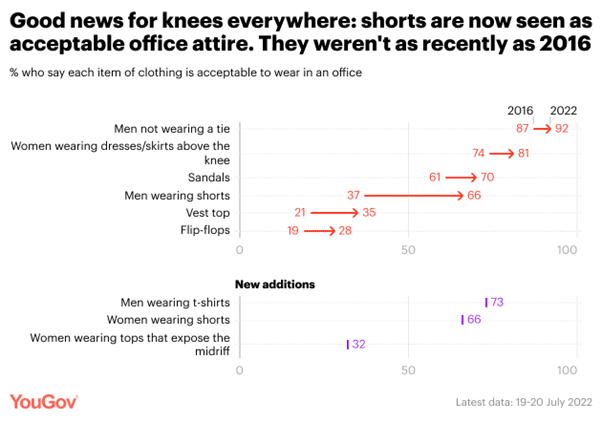Exclusive: Shorts are now acceptable work wear
For both men and women, according to YouGov.
Why You Should Care
COVID-19 has relaxed the world of work.
We've moved towards remote work, as well as more casual work wear.
Find out why suits are out, and t-shirts and shorts are in, according to YouGov.
The pandemic completely disrupted working norms.
Of course, COVID-19 pushed employees who had worked five days in the office to work from home full-time – and now many are reluctant to go back to the way things were. Instead, the dominant future of work model seems to be hybrid where employees split their time between an office and remote locations.
But the pandemic has done more than impact where people work, it has also accelerated other working trends. While UNLEASH has written a lot about the growth of asynchronous working (and the concept of core working hours), as well as the four-day week, we’ve done less on the impact of COVID-19 on what people wear to work.
It appears that COVID-19 has sped up existing trends around the relaxation of office norms, particularly the clothes that people to wear to work (whether from home or in the office).
2021 US research by Samuel Hubbard found that 73% said their office was getting more relaxed, and 54% have seen the dress code shift to being more casual.
82% of the 2,000 US respondents added that they felt that being comfortable in their clothes helps them be more productive.
In fact, 71% said being in casual clothes helped them feel more accomplished as they focused on work, rather than worrying about how uncomfortable they feel. 43% noted they wouldn’t be able to do their jobs effectively if they had to wear more formal, conservative clothes.
What can you now wear to work?
So, it is clear that casual clothes are more acceptable at work, but what precise clothes are appropriate, and which items are still not okay at work, and particularly for the office?
Research by YouGov, shared exclusively with UNLEASH, shows that ties and suits are out, whiel t-shirts and shorts are in.
Workers are more on board with men foregoing wearing a tie to work in 2022 than in 2016. 92% of 2,000 Brits told YouGov’s RealTime survey that not wearing a tie was acceptable, up 5 percentage points from 87% in 2016.
In 2022, 66% of Brits surveyed said it was okay for men to wear shorts at work, while 29% disagreed. This is a dramatic change on 2016 figures where 56% frowned upon men wearing shorts at work – and only 37% were supportive.
The 2022 stats were the same for women wearing shorts; with 66% of Brits supporting it.
YouGov did not share the stats in 2016 for women wearing shorts, but the main shift around womenswear and the workplace was whether people were supporting of them wearing skirts above the knee – over the past eight years, the acceptability of short skirts at work has risen 7 percentage points from 74% to 81%.
While shorts and short skirts might be okay for women at work, crop tops were still deemed inappropriate by 60% of those surveyed. Interestingly, women were most opposed to crop tops with 75% saying they weren’t okay. Men were split with 46% against to 44% pro.
Skepticism also remains around vest tops and flip-flops in the workplace. While 70% of the respondents supported sandals, just 28% were pro-flip flops. This is up 9 percentage points on 2016 figures though.
Regarding vest tops, 35% in 2022 said yes, compared to just 21% in 2019. T-shirts seem to be acceptable, however, with 73% supporting men wearing this garment – YouGov didn’t publish figures on women wearing t-shirts at work.

The social acceptability of wearing summer clothing at work is great news given that the UK in particular is facing a supremely hot summer. In mid-July, a thermometer near London’s Heathrow Airport recorded 40 degrees Celsius for the first time ever.
Ultimately, in those kinds of temperatures, why should people be forced to wear formal clothes to work?
Even beyond the heat, we talk a lot about bringing your best self to work, and part of that is how comfortable you feel in yourself, which extends to your clothes.
All this data begs the question: could COVID-19 be the final nail in the coffin for formal work wear?
The world’s HR conference and expo is back! Don’t miss out on UNLEASH World in Paris this October.
Sign up to the UNLEASH Newsletter
Get the Editor’s picks of the week delivered straight to your inbox!

Chief Reporter
Allie is an award-winning business journalist and can be reached at alexandra@unleash.ai.
